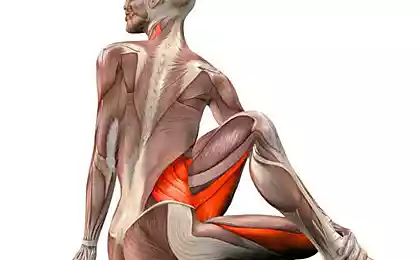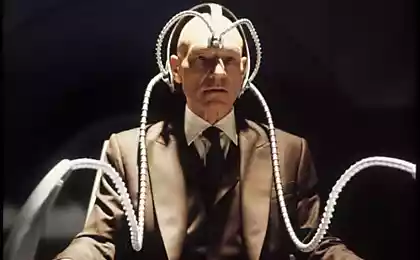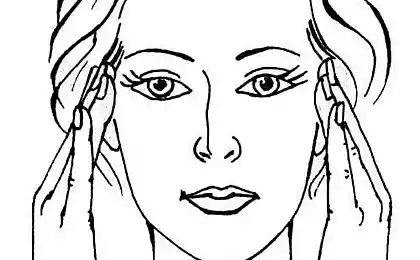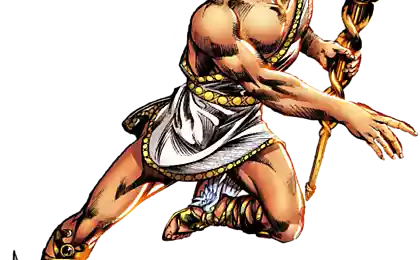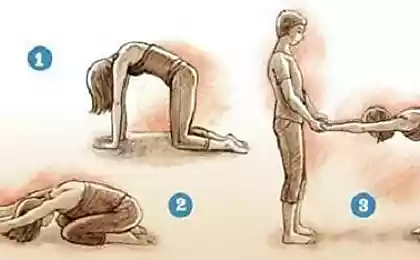266
Exercises that give the maximum healing and rejuvenating effect
Exercises for Active LongevityMuscle energy with our will, we can direct both for the benefit of health and for harm. Working or exercising to exhaustion, lifting excessive weights, destructive very sharp movements or unamortized jumps. As a result, instead of benefit, there is a depletion of the body's resources, the accumulation of dystrophic changes in the joints and spine. In this section, there are several exercises that, with minimal expenditure of muscle resources, give the maximum healing effect.

Exercise to compensate for uprightness and hypodynamia
It's calledelbow swing? The exercise is based on the imitation of the running of a four animal, since the anatomical structure of the human body retains adaptation to such a position and movement. Exercise, with its regular performance, allows you to compensate for the disadvantages of erect walking, quickly remove stagnation in all organs, improve blood supply to the head and liquor dynamics. Exerciseelbow swingIt is more physiological and effective per unit of time spent than running, standing on the head and many other exercises, and is performed easily.
Take the starting position:
1. Kneel in the middle and along on the sleeping mattress so that the knees and toes rest simultaneously on the mattress.
2. Measure the 3-width of your palm from your knees forward and mark or just remember this place. Put your hands on it at the width of your shoulders and lean on them. At the same time, place your head on the palms so that the tips of the fingers of your hands touch the head, and the other edge of your palms closes your eyes.
3. Blink without opening your eyes and feel the eyelids touching your thumb muscles.
Performing the exercise:
Attention! When performing the exercise, the elbows of the hands and knees of the legs do not break off from the mattress for a second, and the tips of the fingers of the hands do not break off from the head. Breathing is free.
1. Move the bodyforwardPut your head together with your palms on a mattress, and the palms from your eyes should be torn off, and the tips (about two phalanges) of your fingers should hold your head by the head with moderate effort. Stay in this position for 1-2 seconds
2. Move the bodybackwards(without tearing the elbows of the hands and knees of the legs from the mattress) try to touch the calf muscles with your hips, while again closing your eyes with your palms without tearing the tips of your fingers from the calf. Hold in this position for 2-3 seconds.
3. Repeat moving forward and backward (swing) several times. Start with a number of swings that are easily done, but no more than 10.
4. Add the number of swings at 1-3 per week. Increase gradually so that the exercise is always done easily. As you master the exercises, gradually increase the rate of swinging. Everyone chooses the optimal pace for himself so that the exercise is performed easily, but not faster than on the count.one-two-and-a-go.one-and-two-backwards.
The exercise can be performed 2-6 times a day. The optimal number of swings is 20-50 - and depends on age.
Note 1: Depending on the ratio of the length of the hips and forearms, it may be necessary to put a blanket folded several times under the elbows or something else so that when moving back in the extreme position, the shoulders are slightly higher than the hips.
Note 2: After 1-3 months, as you master the exercise and gain more flexibility, the exercise is complicated by:
Exercise to remove stagnant phenomena
The exercise is performed in the morning immediately after waking up, without getting out of bed and at night, if necessary, remove stagnation.
Exercise prevents lymph stagnation. You can make a few movements 2-3 times a night without getting out of bed. It is recommended for those who have morning swelling, weakness, arrhythmia, morning high blood pressure.
Reference:
The Way to Active Longevity This is the daily performance of exercises to compensate for upright walking, exercises to relieve stagnation and compensate for the deficiency of biological microvibrations through formation procedures.
Is running harm or good?
Running is traditionally considered a wellness exercise, but improper running can cause great harm to the health of the joints and spine.
The healing or destructive result of running depends on the resources currently available in the body, spine health, running techniques, shoes. Running does not increase the body’s resources, but rather actively consumes them.
The question then is, what is the purpose of running? The main purpose of running is to train the muscles involved in the cushioning of the joints and spine. Of course, during the run there is a shake of internal organs, lymphatic drainage improves, but all this can be achieved with lower energy costs and without the risk of shock overload of the joints and spine. Therefore, exhausting running in inappropriate shoes, landing on the heels is devoid of any sense and harmful to health.
Benefits can be expected only under such conditions:
Running is contraindicated: in diseases of the spine and joints, physical fatigue, chronic fatigue, the elderly.
Walking as an exercise
The Taoist sages said, “Go as a cat walks.”
Elderly people run is contraindicated - they are advised to walk. But walking will benefit only if it is treated as an exercise.
In our lifetime, we take more than 100 million steps – big, small, agile and awkward. Every unsuccessful step can bring shock overload.
The number of unsuccessful steps determines the rate of accumulation of damage in the joints and spine - a drop of stone sharpens.
Why is this happening? The fact is that a soft gait that protects the cells of the joints and spine from damage requires a lot of muscle resources. When they are lacking, the person begins. stomping, dragging, stumbling. In this state, even walking will not be useful.
In order to return softness to the gait, it is necessary to increase the accumulated resources of the body in the cells and valuepublished
P.S. And remember, just changing our consumption – together we change the world!
Source: psyhealth.jimdo.com/%D0%BF%D1%80%D0%B0%D0%B0%D1%82%D0%B8%D1%87%D0%B5%D1%81%D0%D0%B9-%D0%B0%D0%D1%81%D0%BF%D0%B5%D0%D0%B0%D0%D1%82-%D0%B0%D0%B0%B0%D1%D1%80%D0%B0%D0%B0%D1%D1%80%D0%D0%B0%D1%8C%D1%D1%D1%8D1%D1%D1%8D1%D1%8D1%D1%D1%D%D1%D1%80%D0%D0%D0%B0%D0%D0%D0%D0%B0%D0%D0%D0%D0%B0%D0%D0%D0%D0%D0%D0%B0%D0%D0%D0%D0%D0%D0%D0%D0%D0%B0%D0%D0%D0%D0%D0%D0%D0%D0%D0%D0%D0%D0%D0%D0%D0%

Exercise to compensate for uprightness and hypodynamia
It's calledelbow swing? The exercise is based on the imitation of the running of a four animal, since the anatomical structure of the human body retains adaptation to such a position and movement. Exercise, with its regular performance, allows you to compensate for the disadvantages of erect walking, quickly remove stagnation in all organs, improve blood supply to the head and liquor dynamics. Exerciseelbow swingIt is more physiological and effective per unit of time spent than running, standing on the head and many other exercises, and is performed easily.
Take the starting position:
1. Kneel in the middle and along on the sleeping mattress so that the knees and toes rest simultaneously on the mattress.
2. Measure the 3-width of your palm from your knees forward and mark or just remember this place. Put your hands on it at the width of your shoulders and lean on them. At the same time, place your head on the palms so that the tips of the fingers of your hands touch the head, and the other edge of your palms closes your eyes.
3. Blink without opening your eyes and feel the eyelids touching your thumb muscles.
Performing the exercise:
Attention! When performing the exercise, the elbows of the hands and knees of the legs do not break off from the mattress for a second, and the tips of the fingers of the hands do not break off from the head. Breathing is free.
1. Move the bodyforwardPut your head together with your palms on a mattress, and the palms from your eyes should be torn off, and the tips (about two phalanges) of your fingers should hold your head by the head with moderate effort. Stay in this position for 1-2 seconds
2. Move the bodybackwards(without tearing the elbows of the hands and knees of the legs from the mattress) try to touch the calf muscles with your hips, while again closing your eyes with your palms without tearing the tips of your fingers from the calf. Hold in this position for 2-3 seconds.
3. Repeat moving forward and backward (swing) several times. Start with a number of swings that are easily done, but no more than 10.
4. Add the number of swings at 1-3 per week. Increase gradually so that the exercise is always done easily. As you master the exercises, gradually increase the rate of swinging. Everyone chooses the optimal pace for himself so that the exercise is performed easily, but not faster than on the count.one-two-and-a-go.one-and-two-backwards.
The exercise can be performed 2-6 times a day. The optimal number of swings is 20-50 - and depends on age.
Note 1: Depending on the ratio of the length of the hips and forearms, it may be necessary to put a blanket folded several times under the elbows or something else so that when moving back in the extreme position, the shoulders are slightly higher than the hips.
Note 2: After 1-3 months, as you master the exercise and gain more flexibility, the exercise is complicated by:
- When moving forward, they try to bend upwards, and the stomach is trying to pull into the chest.
- When moving back, they try to bend down, and the stomach is trying to bulge out.
Exercise to remove stagnant phenomena
The exercise is performed in the morning immediately after waking up, without getting out of bed and at night, if necessary, remove stagnation.
Exercise prevents lymph stagnation. You can make a few movements 2-3 times a night without getting out of bed. It is recommended for those who have morning swelling, weakness, arrhythmia, morning high blood pressure.
Reference:
- Lie on your side on a sleeping mattress and place a pillow under your head, bent your hands at your elbows.
- The upper shoulder, along with the bent hand, we try to put it forward, then back (as much as possible), while trying to squeeze (without effort) the chest with the hand, then straighten, at the same time we make a comfortable exhalation when compressed, and when straightened - a comfortable breath. Do 3-5 swings.
- Repeat the exercise on the other side.
- If the exercise is done easily, the number of swings can be gradually increased to 10 on each side.
The Way to Active Longevity This is the daily performance of exercises to compensate for upright walking, exercises to relieve stagnation and compensate for the deficiency of biological microvibrations through formation procedures.
Is running harm or good?
Running is traditionally considered a wellness exercise, but improper running can cause great harm to the health of the joints and spine.
The healing or destructive result of running depends on the resources currently available in the body, spine health, running techniques, shoes. Running does not increase the body’s resources, but rather actively consumes them.
The question then is, what is the purpose of running? The main purpose of running is to train the muscles involved in the cushioning of the joints and spine. Of course, during the run there is a shake of internal organs, lymphatic drainage improves, but all this can be achieved with lower energy costs and without the risk of shock overload of the joints and spine. Therefore, exhausting running in inappropriate shoes, landing on the heels is devoid of any sense and harmful to health.
Benefits can be expected only under such conditions:
- If we are consciously running as an exercise,
- If we have mastered the technique of running - well cushioned landing muscles of the lower leg and foot;
- if the loads are carefully dosed: duration and pace, they can increase by no more than 5-10% per week;
- if the phases of active running alternate with the phases of sufficient rest.
Running is contraindicated: in diseases of the spine and joints, physical fatigue, chronic fatigue, the elderly.
Walking as an exercise
The Taoist sages said, “Go as a cat walks.”
Elderly people run is contraindicated - they are advised to walk. But walking will benefit only if it is treated as an exercise.
In our lifetime, we take more than 100 million steps – big, small, agile and awkward. Every unsuccessful step can bring shock overload.
The number of unsuccessful steps determines the rate of accumulation of damage in the joints and spine - a drop of stone sharpens.
Why is this happening? The fact is that a soft gait that protects the cells of the joints and spine from damage requires a lot of muscle resources. When they are lacking, the person begins. stomping, dragging, stumbling. In this state, even walking will not be useful.
In order to return softness to the gait, it is necessary to increase the accumulated resources of the body in the cells and valuepublished
P.S. And remember, just changing our consumption – together we change the world!
Source: psyhealth.jimdo.com/%D0%BF%D1%80%D0%B0%D0%B0%D1%82%D0%B8%D1%87%D0%B5%D1%81%D0%D0%B9-%D0%B0%D0%D1%81%D0%BF%D0%B5%D0%D0%B0%D0%D1%82-%D0%B0%D0%B0%B0%D1%D1%80%D0%B0%D0%B0%D1%D1%80%D0%D0%B0%D1%8C%D1%D1%D1%8D1%D1%D1%8D1%D1%8D1%D1%D1%D%D1%D1%80%D0%D0%D0%B0%D0%D0%D0%D0%B0%D0%D0%D0%D0%B0%D0%D0%D0%D0%D0%D0%B0%D0%D0%D0%D0%D0%D0%D0%D0%D0%B0%D0%D0%D0%D0%D0%D0%D0%D0%D0%D0%D0%D0%D0%D0%D0%









